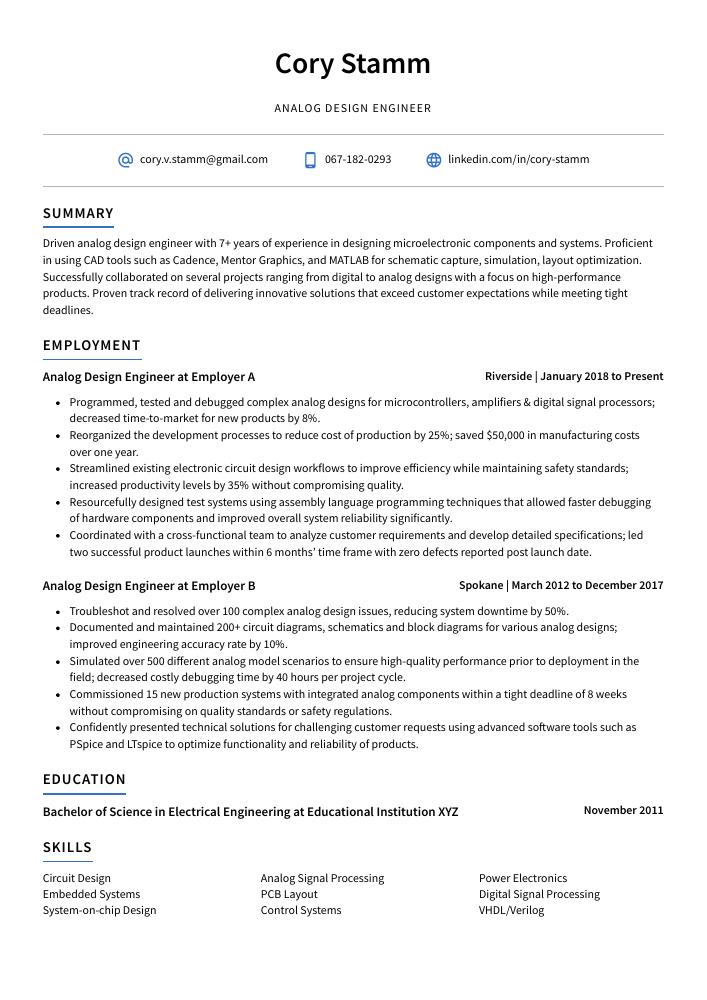Analog Design Engineer Resume Guide
Analog Design Engineers design and develop analog electrical systems, such as amplifiers, filters, and other circuits. They use computer-aided design (CAD) software to create circuit diagrams for testing and implementation in electronic devices. Additionally, they perform troubleshooting on existing designs to identify potential problems or areas of improvement.
You have a knack for creating innovative analog electronic systems, and any engineering team would benefit from your expertise. But hiring managers don’t know who you are yet – to make them aware of what you can do, write an impressive resume that stands out.
This guide will walk you through the entire process of creating a top-notch resume. We first show you a complete example and then break down what each resume section should look like.
Table of Contents
The guide is divided into sections for your convenience. You can read it from beginning to end or use the table of contents below to jump to a specific part.
Analog Design Engineer Resume Sample
Cory Stamm
Analog Design Engineer
[email protected]
067-182-0293
linkedin.com/in/cory-stamm
Summary
Driven analog design engineer with 7+ years of experience in designing microelectronic components and systems. Proficient in using CAD tools such as Cadence, Mentor Graphics, and MATLAB for schematic capture, simulation, layout optimization. Successfully collaborated on several projects ranging from digital to analog designs with a focus on high-performance products. Proven track record of delivering innovative solutions that exceed customer expectations while meeting tight deadlines.
Experience
Analog Design Engineer, Employer A
Riverside, Jan 2018 – Present
- Programmed, tested and debugged complex analog designs for microcontrollers, amplifiers & digital signal processors; decreased time-to-market for new products by 8%.
- Reorganized the development processes to reduce cost of production by 25%; saved $50,000 in manufacturing costs over one year.
- Streamlined existing electronic circuit design workflows to improve efficiency while maintaining safety standards; increased productivity levels by 35% without compromising quality.
- Resourcefully designed test systems using assembly language programming techniques that allowed faster debugging of hardware components and improved overall system reliability significantly.
- Coordinated with a cross-functional team to analyze customer requirements and develop detailed specifications; led two successful product launches within 6 months’ time frame with zero defects reported post launch date.
Analog Design Engineer, Employer B
Spokane, Mar 2012 – Dec 2017
- Troubleshot and resolved over 100 complex analog design issues, reducing system downtime by 50%.
- Documented and maintained 200+ circuit diagrams, schematics and block diagrams for various analog designs; improved engineering accuracy rate by 10%.
- Simulated over 500 different analog model scenarios to ensure high-quality performance prior to deployment in the field; decreased costly debugging time by 40 hours per project cycle.
- Commissioned 15 new production systems with integrated analog components within a tight deadline of 8 weeks without compromising on quality standards or safety regulations.
- Confidently presented technical solutions for challenging customer requests using advanced software tools such as PSpice and LTspice to optimize functionality and reliability of products.
Skills
- Circuit Design
- Analog Signal Processing
- Power Electronics
- Embedded Systems
- PCB Layout
- Digital Signal Processing
- System-on-chip Design
- Control Systems
- VHDL/Verilog
Education
Bachelor of Science in Electrical Engineering
Educational Institution XYZ
Nov 2011
Certifications
Certified Analog Design Engineer
Analog Devices, Inc.
May 2017
1. Summary / Objective
A resume summary for an analog design engineer should highlight your technical expertise and experience in the field. Include details such as specific hardware you have designed, any certifications or awards you’ve earned, and how many years of experience you have working with analog systems. You can also mention the types of projects that are most interesting to you and why they excite you.
Below are some resume summary examples:
Diligent and experienced analog design engineer with 10+ years of experience in designing and developing high-performance electronic systems. Proven track record of success utilizing advanced circuit simulation tools to streamline development processes, improve system performance, and reduce time-to-market. Looking to join ABC Technologies as an Analog Design Engineer where I can leverage my expertise in signal processing to create innovative designs that meet customer needs.
Amicable analog design engineer with 4+ years of experience designing high-performance electronics. Seeking to leverage expertise in analog and mixed signal IC designs at ABC company. At XYZ, designed 3D integrated circuits for a wide range of applications leading to an estimated 5% reduction in product costs per unit. Received the “Outstanding Engineer” award due to contributions including a 15% improvement in power efficiency across multiple products.
Professional analog design engineer with 10+ years of experience designing, testing, and troubleshooting analog circuits. Expert in circuit simulation software such as SPICE and HyperLynx. Successfully developed a wide range of products including voltage regulators, audio amplifiers, power converters, and motor control systems for consumer electronics applications at XYZ Inc. Received several awards for innovation from the company’s management team.
Hard-working and detail-oriented analog design engineer with 5+ years of experience designing, testing, and implementing complex circuit designs. Skilled in the use of various software packages to model electrical systems. Seeking to join ABC Tech as a lead designer for their next generation product line up. At XYZ Inc., designed two high performing products that were launched successfully on time and within budget.
Committed analog design engineer with 8+ years of experience in developing low-voltage and high-frequency analog circuits. Highly experienced in designing complex integrated circuit systems, PCBs, signal processing algorithms, and RF boards. At XYZ Inc., designed a new power amplifier that improved efficiency by 15%. Recognized for excellent technical skills with the ability to work under tight deadlines.
Well-rounded analog design engineer with 10+ years of experience in the semiconductor industry. Expertise in designing and debugging analog circuits, such as op-amps and power amplifiers, using modern EDA tools. Seeking to join ABC Tech’s innovative team of engineers to create high performance products that meet customer needs. At XYZ Inc., improved product yield by 22% while reducing cost by 20%.
Accomplished analog design engineer with 8+ years of experience designing and troubleshooting complex electrical circuits. Skilled in utilizing advanced electronic CAD software to create engineering drawings as well as developing innovative solutions for existing problems. Seeking an opportunity at ABC Corp where I can apply my knowledge and expertise to develop next-generation analog products.
Passionate analog design engineer with 6+ years of experience designing and building components for high-performance audio systems. Skilled in analog circuit design, debugging, and optimization. Seeking to join ABC Technologies to leverage expertise in noise reduction techniques towards the development of innovative products that meet customer demands.
2. Experience / Employment
For the experience section, you should list your employment history in reverse chronological order, starting with the most recent job.
When writing about what you did for each role, stick to bullet points. This makes it easier for the reader to quickly digest the information and understand what you have done. You also want to provide detail on your accomplishments and results achieved; instead of saying “Designed analog circuits,” try something like “Developed high-performance analog circuits that improved signal integrity by 20%.”
To write effective bullet points, begin with a strong verb or adverb. Industry specific verbs to use are:
- Designed
- Simulated
- Analyzed
- Optimized
- Fabricated
- Implemented
- Troubleshot
- Documented
- Programmed
- Modeled
- Tested
- Debugged
- Validated
- Commissioned
Other general verbs you can use are:
- Achieved
- Advised
- Assessed
- Compiled
- Coordinated
- Demonstrated
- Developed
- Expedited
- Facilitated
- Formulated
- Improved
- Introduced
- Mentored
- Participated
- Prepared
- Presented
- Reduced
- Reorganized
- Represented
- Revised
- Spearheaded
- Streamlined
- Structured
- Utilized
Below are some example bullet points:
- Prepared comprehensive analog design schematics and circuit simulations for 10+ projects; tested circuits with 50-100 components, accurately predicting results to within 5% of actual measurements.
- Compiled detailed technical documents outlining component selection criteria, electrical safety regulations, signal flow diagrams and device characteristics; reduced overall project costs by 8%.
- Accurately measured input/output data from a variety of transistors, capacitors and resistors through laboratory testing procedures while identifying ways to improve performance up to 25%.
- Validated functionality in multiple product prototypes against customer requirements prior to final production release; identified design flaws early on in the process that saved $500 per unit produced over an 18 month period.
- Reduced complexity of large scale designs by up to 30%, simplifying PCB routing paths & cutting down time required for debugging processes by 40 hours per project cycle on average.
- Designed and developed over 50 analog integrated circuits for various products, increasing device performance by 30% and reducing power consumption by 20%.
- Introduced 10 new components to enhance circuit stability and accuracy; completed prototype development within 2 months, 1 month ahead of schedule.
- Modeled and simulated a wide range of analog devices in PSpice & MATLAB environment with high degree of accuracy; improved signal integrity up to 80dB at 300MHz bandwidths.
- Debugged complex material issues using oscilloscopes, logic analyzers and other test equipment; reduced product failure rate from 4% to 0%.
- Effectively communicated design requirements among cross-functional teams including Fabrication/Processes Engineering, Quality Control & Marketing departments every step of the way.
- Actively designed, tested and debugged analog integrated circuits for 25+ projects, resulting in 95% success rate of products passing functional testing.
- Tested the performance of various components such as op-amps, regulators and comparators to ensure optimal operation within given parameters; reduced power consumption by 10%.
- Assessed customer requirements & design specifications to develop detailed technical plans of action with consideration towards cost effectiveness; successfully completed 3 major projects on or ahead of schedule.
- Facilitated collaboration between cross-functional teams including hardware engineers, software developers and manufacturing personnel during all stages from concept to production launch; achieved a 15% improvement in product yield rates upon completion of R&D phase.
- Achieved an overall reduction in development time due to thorough analysis techniques coupled with innovative problem solving strategies throughout circuit design process that met industry standards & safety protocols at all times.
- Presented several key design solutions to customers, resulting in the successful implementation of 10+ analog systems and a reduction in customer costs by 15%.
- Improved signal-to-noise ratios for analog circuits used across 3 product lines through optimization techniques and simulations; reduced errors by 20% on average.
- Represented company at industry conferences and seminars, delivering presentations on recent trends & advancements within the field of Analog Design Engineering to over 500 attendees nationwide.
- Implemented innovative design strategies that increased performance levels for 5 existing products while reducing development time by 25%.
- Competently created custom schematics using circuit analysis tools such as SPICE/PSpice, PCB layout software (eagleCAD), MATLAB & HDLs with minimal guidance from senior engineers or supervisors; completed assigned tasks 8 hours ahead of deadlines on multiple occasions.
- Optimized analog circuit designs to improve performance and reduce power consumption by 20%, increasing product life-cycle by 15%.
- Advised senior management on options for new technology solutions, resulting in a $20,000 reduction in cost of components.
- Developed custom analog design prototypes from concept through actualization and testing; led the development of 8 successful products over the last year.
- Utilized cutting edge simulation tools such as SPICE to troubleshoot complex signal integrity issues within analog systems; reduced debugging time by 50%.
- Independently designed high frequency oscillators with an accuracy rate of +/- 1Hz while maintaining signal strength across various temperature ranges; increased reliability rating 5x above industry standard levels.
- Analyzed analog circuit requirements and designed multi-stage analog integrated circuits for a variety of products, resulting in improved power consumption by 17% on average.
- Revised existing designs to address customer issues and produced cost-effective solutions that maximized performance while meeting target deadlines; reduced design time by 10 hours per week.
- Structured complex schematic diagrams and PCB layouts with precision using CAD software tools, achieving 90% accuracy across all projects undertaken within the last year.
- Formulated detailed test plans to ensure compliance with safety regulations before releasing products for market launch; achieved zero product recalls due to malfunctioning circuitry over a period of 6 months consecutive testing cycles.
- Meticulously documented each step taken during the design process – from initial concept through prototyping stages – improving efficiency up to 20%.
- Spearheaded the design of 3 new analog products, resulting in a 15% increase in production efficiency and $2 million savings for the company.
- Demonstrated technical expertise by creating highly accurate schematics to simulate electrical designs using SPICE software; improved power performance by 10%.
- Efficiently troubleshot quality issues with existing semiconductor devices and identified solutions that increased operational reliability and reduced downtime by 25%.
- Expedited prototype development timelines from 8 weeks to 5 weeks through process automation; created an iterative feedback loop between engineering teams & customers which resulted in 18% fewer design iterations before launch.
- Mentored 2 junior engineers on circuit board assembly processes and best practices, leading them to successfully develop 6 prototypes within budget during their first project cycle without any supervision or guidance required after initial training period.
3. Skills
Skill requirements will differ from employer to employer – this can easily be determined via the job advert. Organization ABC may require a candidate to be proficient in analog circuit design, while Organization XYZ may need someone with expertise in digital signal processing.
It is important to tailor the skills section of your resume for each job you are applying for because many companies use applicant tracking systems that scan resumes for certain keywords before passing them on to humans. This means that if your skill set does not match what they are looking for, then it won’t even get seen by an actual person.
Therefore, make sure you list all relevant skills and qualifications here; additionally, elaborate further on key ones throughout other sections of your resume such as the summary or experience section.
Below is a list of common skills & terms:
- Analog Signal Processing
- Circuit Design
- Control Systems
- Digital Signal Processing
- Embedded Systems
- Mixed-signal Design
- PCB Layout
- Power Electronics
- System-on-chip Design
- VHDL/Verilog
4. Education
Mentioning your education on your resume will depend on how far along you are in your career. If you have just graduated and have no work experience, include an education section below the objective statement. On the other hand, if you’ve been working as an analog design engineer for several years with plenty of relevant experience to showcase, it is perfectly acceptable to omit this section altogether.
If including an education section, make sure to mention courses and subjects related directly to the job at hand that demonstrate a mastery of analog engineering concepts.
Bachelor of Science in Electrical Engineering
Educational Institution XYZ
Nov 2011
5. Certifications
Certifications are a great way to demonstrate your expertise in a particular field. Employers will be interested in seeing what professional development courses you have taken and if you have kept up with industry trends.
Including any certifications related to the job on your resume can help give employers an idea of how well-versed you are in that area, making it easier for them to decide whether or not they should hire you.
Certified Analog Design Engineer
Analog Devices, Inc.
May 2017
6. Contact Info
Your name should be the first thing a reader sees when viewing your resume, so ensure its positioning is prominent. Your phone number should be written in the most commonly used format in your country/city/state, and your email address should be professional.
You can also choose to include a link to your LinkedIn profile, personal website, or other online platforms relevant to your industry.
Finally, name your resume file appropriately to help hiring managers; for Cory Stamm, this would be Cory-Stamm-resume.pdf or Cory-Stamm-resume.docx.
7. Cover Letter
Writing a cover letter is a great way to show potential employers who you are and why you’re the best fit for their company. It’s usually composed of 2 to 4 paragraphs that provide more information than what can be found in your resume.
Cover letters aren’t always mandatory, but they do give recruiters better insight into your qualifications and personality. Including one with an application is highly recommended as it could make all the difference when it comes to getting hired!
Below is an example cover letter:
Dear Harold,
I am writing to apply for the Analog Design Engineer position at your company. With experience in designing, testing, and optimizing analog circuits, as well as a strong understanding of signal processing and electrical engineering principles, I believe I would make a valuable addition to your team.
In my current role at [company name], I have designed analog circuits for a variety of applications including power management, data conversion, and sensor interface. My work has involved both discrete component and integrated circuit design using Cadence OrCAD tools. In addition to my design experience, I have also been responsible for PCB layout and routing, as well as overseeing fabrication and assembly processes. Through this work, I have gained an in-depth knowledge of manufacturing processes and procedures that will be beneficial in ensuring successful product implementation.
I am confident that my skills and experience will contribute to the success of your organization. I look forward to discussing how I can be of value during an interview at your earliest convenience. Thank you for your time and consideration.
Sincerely,
Cory
Analog Design Engineer Resume Templates
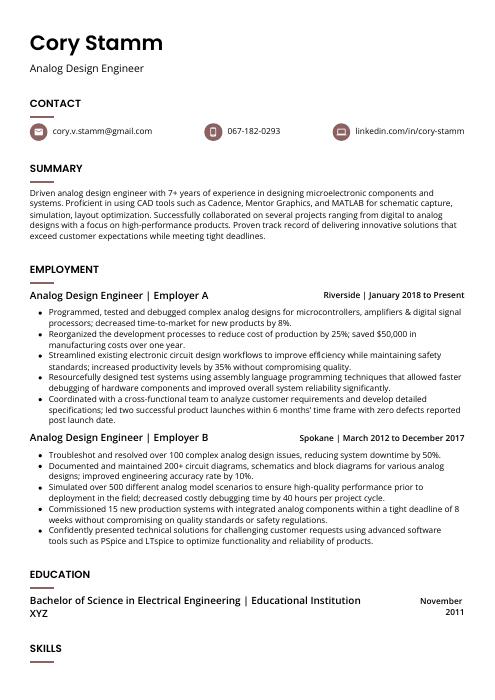 Fossa
Fossa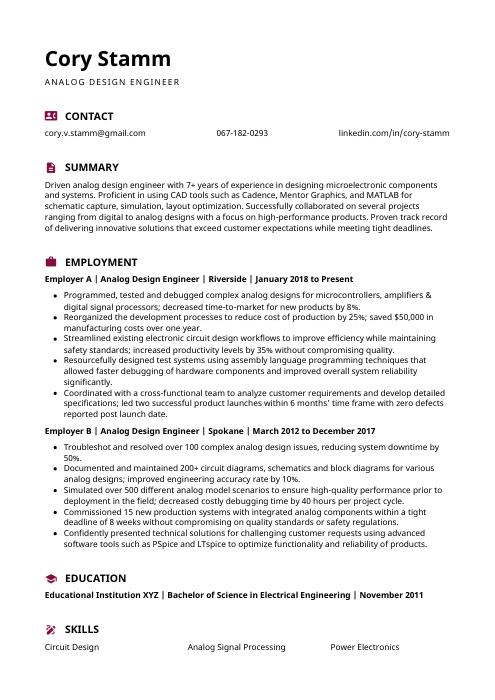 Hoopoe
Hoopoe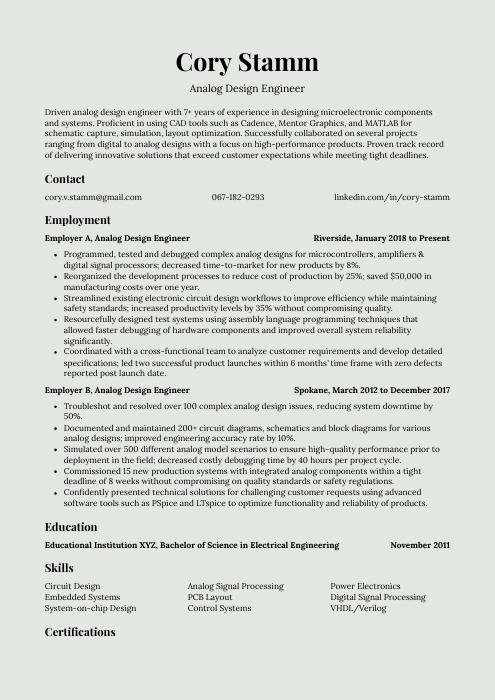 Saola
Saola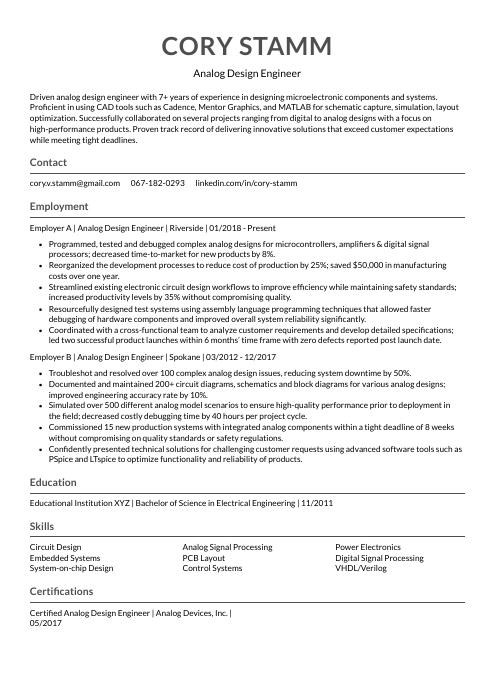 Indri
Indri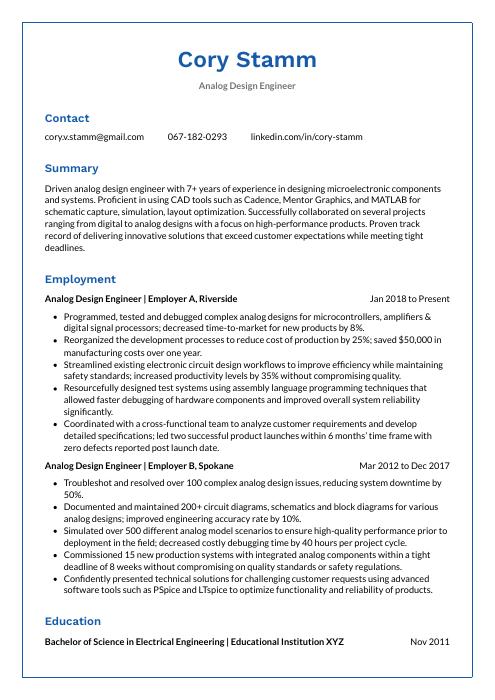 Markhor
Markhor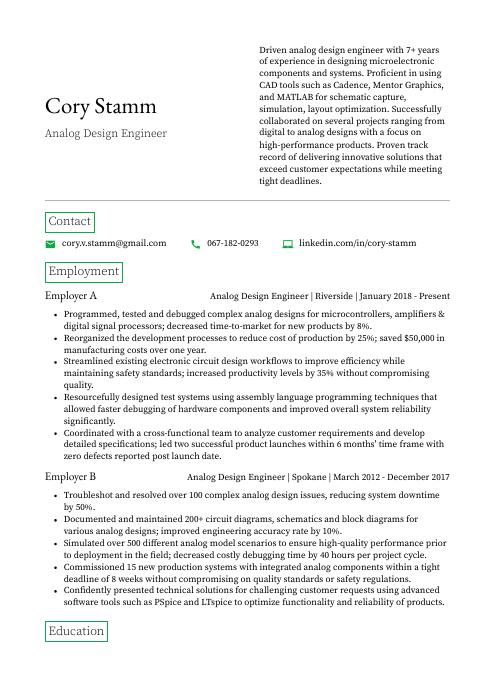 Quokka
Quokka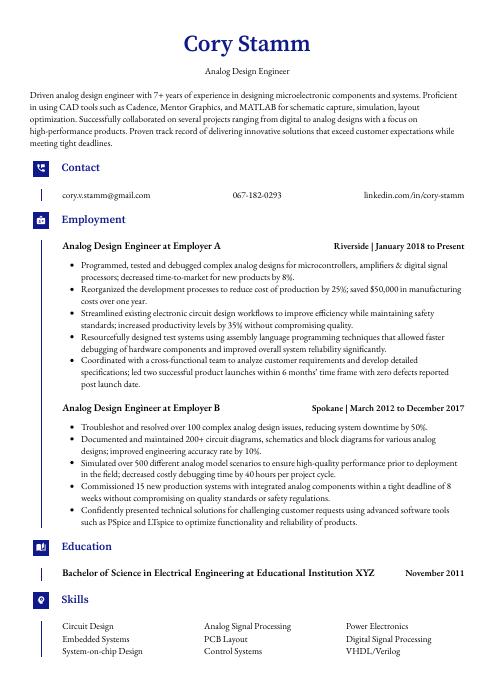 Gharial
Gharial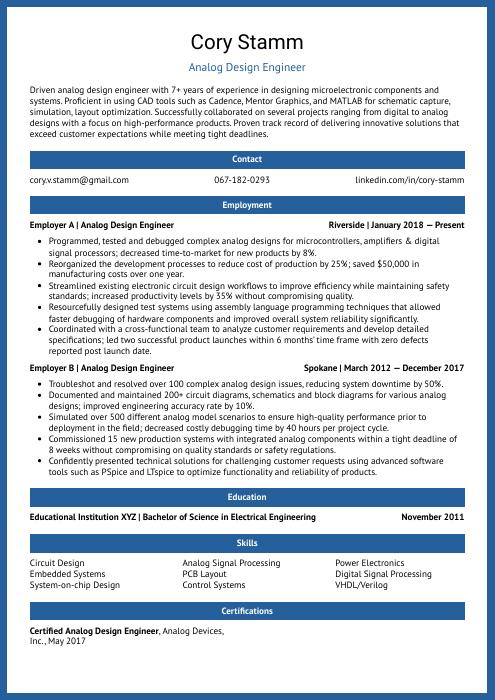 Ocelot
Ocelot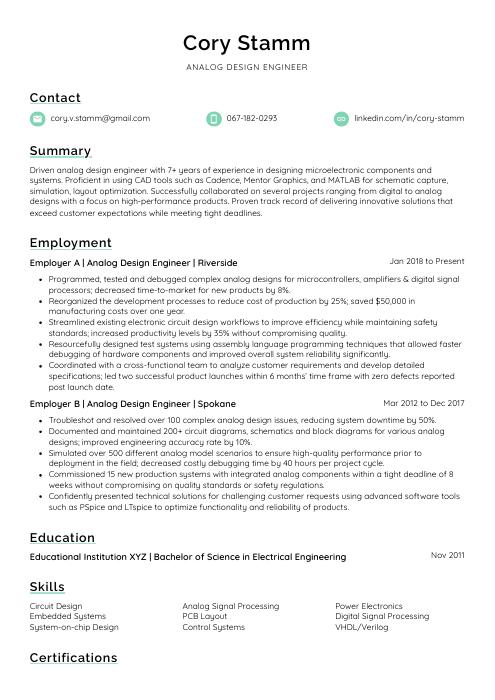 Lorikeet
Lorikeet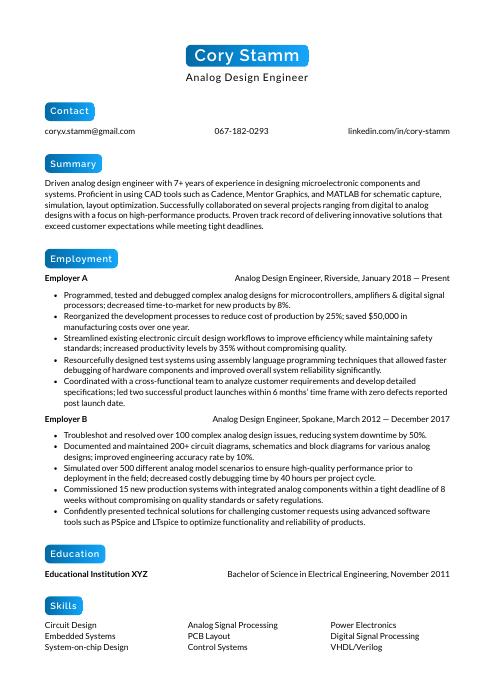 Kinkajou
Kinkajou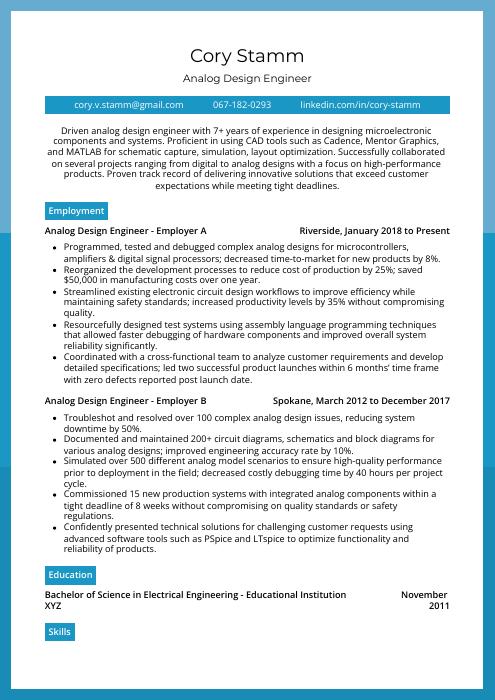 Rhea
Rhea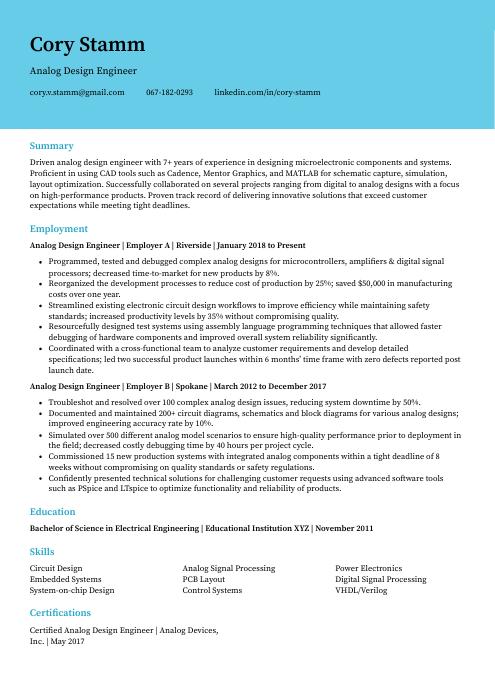 Dugong
Dugong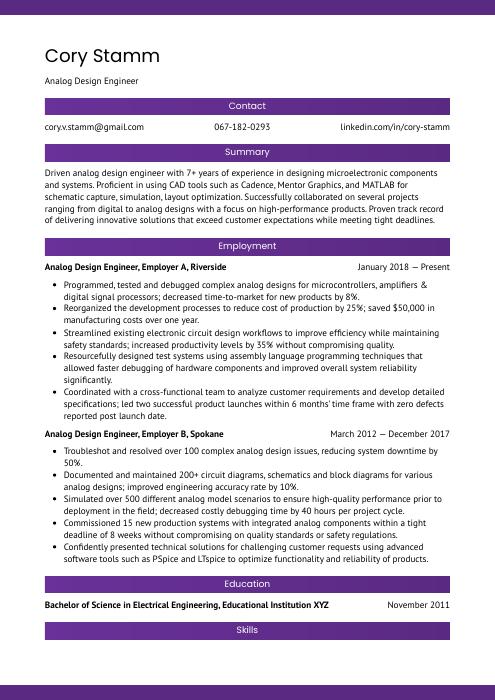 Jerboa
Jerboa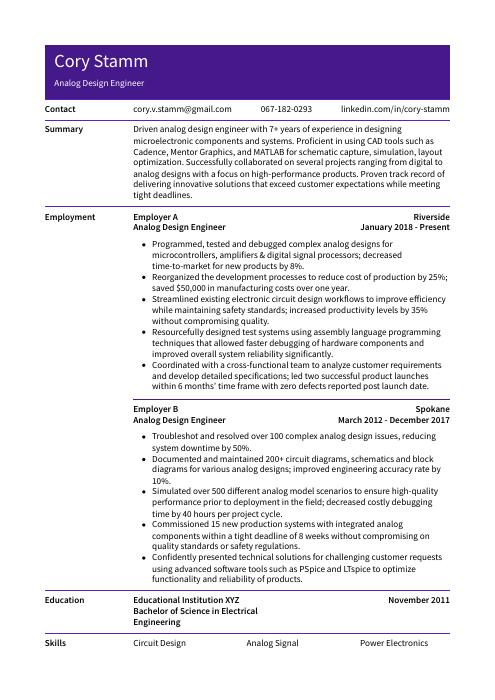 Pika
Pika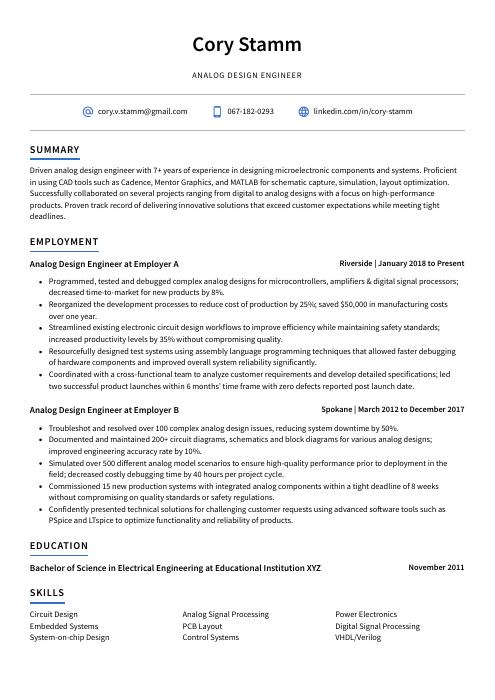 Axolotl
Axolotl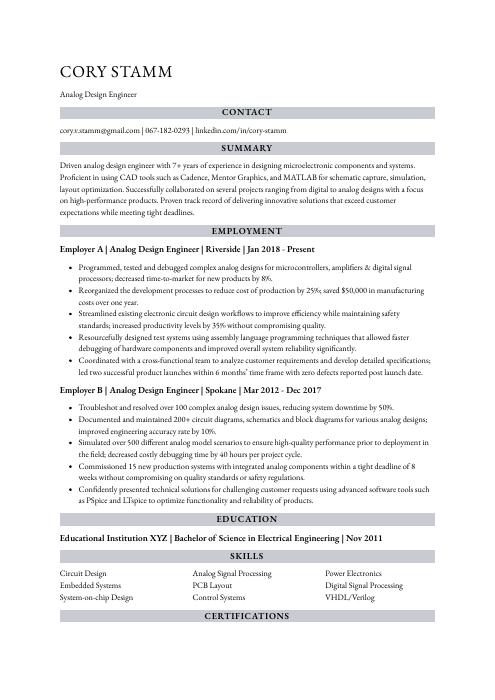 Numbat
Numbat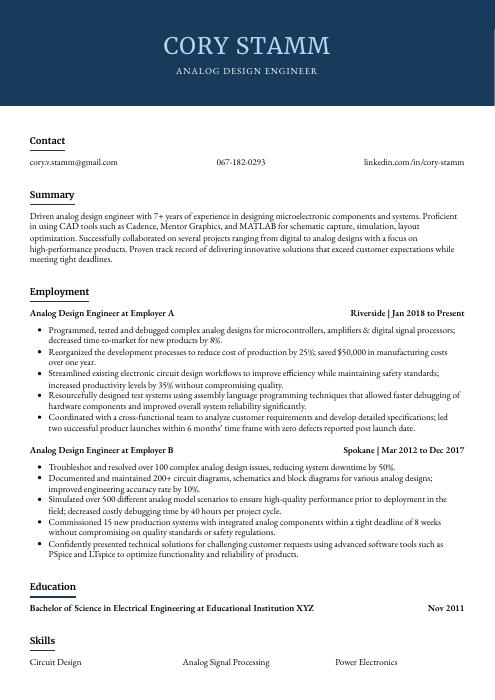 Bonobo
Bonobo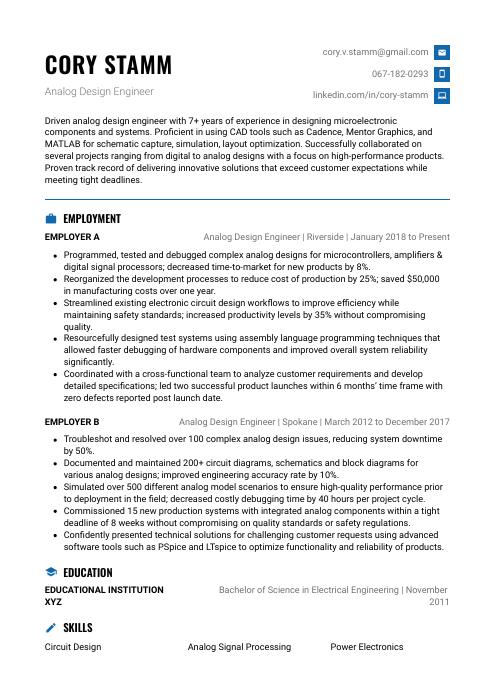 Echidna
Echidna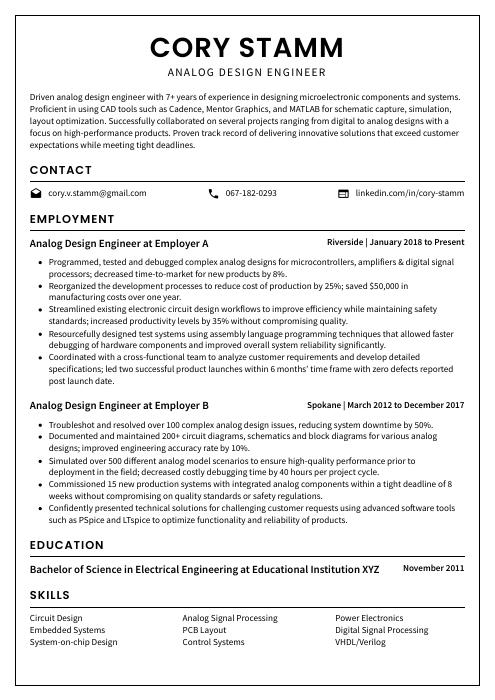 Cormorant
Cormorant Rezjumei
Rezjumei
